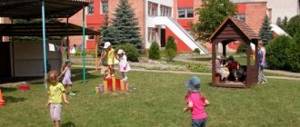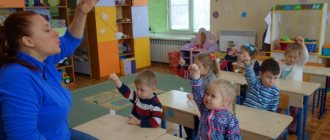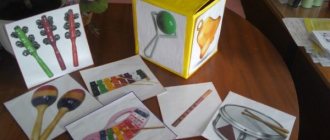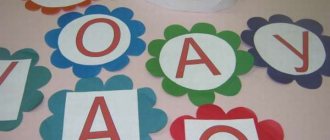Long-term planning of work with parents in the preparatory group
Long-term plan for interaction with parents.
September
- Organizational parents' meeting "Age characteristics of children in the preparatory group for school."
Purpose: To familiarize parents with the requirements of the kindergarten education program for children aged 6-7 years.
- Parent meeting “Your child has arrived at kindergarten.”
Goal: To set up parents for active, collaborative and pedagogically correct work to ensure good adaptation to the new group and teachers.
- Conversation with parents “Children’s clothing in different seasons”, “Enteroviral infections”
- Purpose: To talk about the effect of negative factors (hypothermia, overheating, etc.) that cause irreparable harm to the baby’s health. Help parents maintain and strengthen the physical and mental health of their child.
- Reading competition "Blue Bird"; Competition of crafts made from natural materials “Gifts of Autumn”.
Goal: To activate parents and children to participate in competitions
- Parent survey. Topic: “What kind of parent are you?” Individual consultations at the request of parents.
Goal: Dissemination of pedagogical knowledge among parents.
culture of behavior
October
- Consultation “Game as a means of educating preschool children”
Goal: Dissemination of pedagogical knowledge among parents, theoretical assistance to parents in matters of raising children.
- Recommendations for parents “How to choose the right toy.”
Goal: Dissemination of pedagogical knowledge among parents.
- Individual conversations with parents about the need to vaccinate against influenza and ARVI. "Enteroviral infections"
- Consultation “Hardening”
- "Age characteristics of children of senior preschool age."
Goal: Improving the pedagogical culture of parents.
- Consultation for parents “Outdoor play and the life of a child.”
Goal: to provide knowledge about the importance of outdoor games, their meaning, selection for children of this age.
November
- Consultation “Main directions in the development of speech in children of preparatory school age”
Goal: Uniting the efforts of teachers and parents to develop children’s speech activity
- Conversation “Road safety. Is it easy to teach a child to behave correctly on the road?
Goal: Implementation of a unified educational approach to teaching children traffic rules in kindergartens and at home.
- "Physical training! Hooray! Hooray!" (reminders, recommendations on healthy lifestyle, prevention of flat feet, posture; sets of exercises).
Target:
Promote a healthy lifestyle, introduce measures to prevent flat feet and poor posture. Offer sets of exercises and interesting outdoor games.
- Preparation and holding of the Mother's Day holiday
Goal: To foster love and respect for mother, to create a kind, warm atmosphere between generations.
- Campaign “Help those around you”
(Parents and children making bird feeders together)
- Individual conversations with parents on issues that arise.
Goal: increasing the pedagogical literacy of parents in one or another area of raising and educating children.
December
- Parent meeting “Being healthy is stylish, fashionable!”
Goal: To introduce the values of healthy lifestyle, to cultivate an emotionally positive attitude of parents towards healthy lifestyle.
- Decorating a parent’s corner with a winter theme “Hello, guest Winter!”
- Consultation for parents “Outdoor games in winter.”
Goal: to provide knowledge about the importance of outdoor games in winter, their meaning, selection for children of this age.
- Memo for parents “How to answer children's questions?”
Goal: Improving the pedagogical culture of parents.
- Competition for parents “The best DIY New Year's toy.”
Goal: to attract parents to joint artistic activities at home, the creative activity of parents and children.
- Joint preparation for the New Year's party.
Goal: to create interest and desire in children and parents to jointly decorate the group for the holiday.
January
- Individual conversations. Topic: “Hardening is one of the forms of preventing colds in children
Goal: Formation of a unified approach to methods of healing and hardening children in kindergarten and at home
- How to cultivate perseverance.
Purpose: Recommendations for organizing games with active children.
- Interest club “Unconventional methods of drawing”
Goal: To introduce parents to unconventional drawing methods
- Consultation: “Prevention of influenza, ARVI.”
Goal: to help parents maintain and strengthen the physical and mental health of the child.
- Design of the photo exhibition "New Year's holidays"
.
Goal: To intensify the participation of parents in the life of the group.
- “Preparing a preschooler’s hand for writing.”
Purpose: To provide recommendations to parents on preparing their child for school.
February
- "Secrets of raising a polite child."
Goal: Dissemination of teaching experience among parents.
- Games and exercises to develop logical thinking.
Goal: Development of the educational potential of the family.
- "The role of the father in raising a child."
Goal: To clarify ideas about the functions of a man in the family. Changes in the position of fathers in relation to issues of education.
- Exhibition of children's drawings “My dad is the best!”
Goal: To attract the attention of parents to the creativity of children.
- Holding a holiday for dads “Defender of the Fatherland Day”
Goal: to get positive emotions from the holiday, satisfaction from participation, to foster unity and sociability.
- Individual consultations at the request of parents.
Goal: to provide parents with timely assistance on this or that issue of education, to contribute to the achievement of a common point of view on these issues.
March
- Decorating a parent's corner with a spring theme
"Spring is red."
Goal: To attract parents' attention to new information in the corner.
- Invitation of women to a matinee dedicated to International Women's Day on March 8.
Goal: to get positive emotions from the holiday, satisfaction from participation, to foster unity and sociability.
- Design of a sliding folder “Health-saving approaches in the system of educational activities of a kindergarten.”
Goal: To familiarize parents with the work of the kindergarten on health-saving technologies and protecting the health and lives of children.
- “Development of a child’s creative abilities”.
Purpose: To highlight to parents the requirements of the program for the art activities of senior groups.
- Memo for parents “How to spend a day off with children.”
Goal: improving the pedagogical culture of parents.
- “Hardening is one of the forms of preventing colds in children.”
Goal: To familiarize parents with the tasks of preserving and improving the health of children.
- Individual conversations with parents on issues that arise
.
April
- Exhibition of creative works for Cosmonautics Day.
Goal: To attract the attention of parents to the creativity of children.
- Folder – moving “Holiday – Happy Easter!”
- Consultation for parents “Children’s safety is the concern of adults.”
Goal: to unite the efforts of teachers and parents to introduce children to the basics of safe behavior on the street and at home.
- Visual information “Didactic game as an important means of mental development of children.”
Goal: to provide knowledge about the importance of didactic games for the mental development of children, their meaning, and selection for children of this age.
- Individual conversations with parents on issues that arise.
May
- Consultation for parents “Outdoor games for a walk.”
Goal: to provide knowledge about the importance of outdoor games during walks for children of primary preschool age, their meaning, and selection for children of this age.
- Consultation for parents “About summer holidays for children”
Goal: introducing families to a healthy lifestyle, active recreation, and sports.
- Improvement of the kindergarten site, assistance from parents
Goal: to activate parents’ initiative in improving children’s areas.
- Design of the wall newspaper “Our good deeds”.
Purpose: photo report of the work done.
- Encouraging parent activists with thanks and certificates.
- Parent meeting “Let’s sum it up...”.
Purpose: to summarize the past academic year, outline goals and objectives for the next academic year.
Health saving games.
"Far close".
Alternately look at the object selected outside the window and at the object in the group.
“Guess who called?”
Train the hearing organs and activate the attention and auditory memory of children.
"Find a match."
Match objects to objects based on tactile sensations (blindfolded). Equipment: buttons, cubes, apple, pencils, small objects.
"Rules of hygiene."
Using the reader, the driver is selected and leaves the group. The teacher and the children agree on who will portray what and what. Then the driver is invited, the children take turns demonstrating hygiene skills using gestures and facial expressions. The presenter must guess what the children are showing.
"Etiquette school of graceful manners."
Teach the child table manners, tell what dishes and foods are eaten using cutlery, and teach how to handle cutlery.
“Guess the riddle from the picture.”
Help children remember the main group of dangerous objects and develop attention.
"Find dangerous objects."
Help children remember objects that are dangerous to life and health, help them independently draw conclusions about the consequences of not handling them carefully.
"My day"
Talk about your daily routine, develop the ability to explain and prove your point of view; learn to find violations of patterns in a sequential series.
"Dangerous - not dangerous."
Teach children to distinguish dangerous life situations from non-dangerous ones, be able to foresee the result of a possible development of the situation, consolidate knowledge of the rules of safe behavior; cultivate a sense of mutual assistance.
“If I do this.”
Draw children's attention to the fact that in every situation there can be two ways out; one is dangerous to health, the other is harmless; cultivate a caring attitude towards yourself and other people, protect others, and not cause pain; develop thinking and intelligence.
"Ambulance".
To strengthen children’s knowledge and practical skills in first aid.”
"Journey to the land of health."
To strengthen children’s ideas about how to help themselves and others always stay healthy.”
“Dunno came to us.”
To develop in children the ability to keep their body clean and their clothes neat; teach to see the implausibility of the proposed situation, its absurdity.
"Healthy and unhealthy food."
Strengthen children's ideas about which foods are healthy and which are harmful to the body.
"What do you know".
Talk about the structure, work, characteristics of the human body, rules for caring for it, first aid in various situations, develop attention and memory.
“Touch to...”
All players are dressed differently. An adult shouts:
“Touch...blue!”
Everyone must instantly orient themselves, find something blue in the participants’ clothes and touch this color.
The colors change periodically. Those who didn’t have time to become a presenter.
"Mirror"
Children are asked to imagine that they entered a mirror store. One half of the group is “mirrors”, the other is various “little animals”.
The “little animals” walk past the “mirrors,” jump, and make faces. “Mirrors” must accurately reflect the movements and facial expressions of the “animals”.
"Good Animal"
Participants stand in a circle and join hands. The adult says: “We are one big, kind animal. Let's listen to how it breathes! Everyone listens to their breathing and the breathing of their neighbors.
The adult says: “Now let’s breathe together!” Inhale - everyone takes 2 steps forward, exhale - everyone takes 2 steps back. The adult explains: “This is how the animal not only breathes, its kind heart beats just as clearly and evenly. Knocking is a step forward, knocking is a step back. We all take the breath and heartbeat of this animal for ourselves.”
Card index of conversations with children of the preparatory group according to the Federal State Educational Standard
These conversations in the preparatory group (a card index with goals for the Federal State Educational Standard is the basis) will help in conducting interesting and productive classes with preschoolers. The Federal State Educational Standard helps to comply with uniform requirements for the preparation of children. There are a lot of topics for conversations that will be interesting for children:
- space;
- traffic regulations;
- profession of firefighter and his work;
- garden;
- my home street;
- hour, minute and second;
- ecology and others.
Conversation at the preschool educational institution
Conversations in March in the preparatory group
The title of the conversation is “The Happy Month of March.”
Goal: Systematize knowledge about spring and International Women’s Day.
Progress:
- “Guys, please tell me what three spring months you know! Right! March, April and May."
- “Who can tell what happens to nature in March?”
- “If December is the beginning of a fierce winter, then March is the beginning of a wonderful spring.”
- “The guest spring arrives, the snow begins to melt, the rooks arrive, the sun shines warmer and brighter, and winter recedes. Nature is slowly waking up from hibernation.”
- “And our main spring holiday is March 8 or International Women’s Day. The first person we congratulate on this holiday will always be mother.”
Fire theme
Conversation about spring in the preparatory group
The goal is to systematize and clarify children’s knowledge about spring. To teach to see the dependence of living nature on inanimate nature. Learn to generalize signs.
The tasks are to clarify and systematize knowledge about the signs of spring, to list the spring months.
For your information! It is important to teach children to talk about the content of the poem after listening. Convey the emotions received from listening to the poem.
It is worth teaching how to receive aesthetic pleasure from spring nature.
Interesting! Preliminary work - a walk around the territory of the kindergarten in the spring. Reading a poem about spring. Drawing on the theme “Spring has come.” Listening to a song about spring. View illustrations and paintings about spring. Individual puzzle about spring.
Demo material:
- Reproduction of a painting by S.A. Vinogradov "Spring".
- Children's song (recording) “Spring Drops”.
- Presentation with pictures for the poem.
Handout - illustrations about spring.
Equipment:
- easel;
- MP3 player;
- laptop and projector.
Methodical techniques:
- conversation-dialogue;
- a game;
- listening to a song;
- looking at illustrations.
Spring theme
Progress of the conversation:
- “Guys, listen to Agracheva’s children’s poem “Spring.”
- “Which poem is this - sad or funny? Why?"
- “How does boron change in spring? The snow melts in it, it becomes lighter, and thawed patches form.”
- “What animals are the poem talking about? About the bear, hares, rooks, hedgehogs, squirrels, songbirds.”
- “How are they feeling with the arrival of spring? The bear wakes up, the bunnies, rook, hedgehog, and squirrel are happy and active. The birds begin to sing.
- “How do you feel with the arrival of spring?”
- “Name the birds and animals that winter in Russia: elk, hare, wolf, fox, bear, raven, crow, sparrow, arctic fox, squirrel, sable, hedgehog, tit, jackdaw, pigeon, wood grouse, wild boar, vole, owl, eagle owl, waxwing, partridge.”
- “List the spring months (March, April, May). March is the first month of spring. It comes when February ends. Rooks and sparrows arrive, make noise, and tits clink. The bear wakes up. But it may still be warm in March.”
- “Who remembers what holiday is celebrated in March? That's right - March 8th. It's International Women's Day."
- “April is the second or middle month of spring. Streams are flowing because the sun is shining brighter and the snow is melting. Thawed patches appear. The buds of the awakening trees are swelling. Coltsfoot is blooming. Bunnies exchange their winter down for summer.”
- “In May (the last month of spring) it is already getting warmer. The snow has melted, the first rains and even thunderstorms with thunder and lightning are coming. Apple, lilac, cherry and other trees are blooming.”
- “And in May, what national holiday is celebrated in our country - Victory Day. Victory over Nazi Germany."
- Physical education session to the song “Spring Drops”.
- Viewing a reproduction of a painting by S.A. Vinogradov "Spring". “What signs of spring can be seen in this picture? More sun, snow melts and thawed patches appear, leaves bloom on the trees.”
How children dance in kindergarten in a playful way and with an accelerated tempo
Conversation with children of the middle group “Maslenitsa”
The title of the conversation is “Daring Maslenitsa.”
The goal is to introduce children to Russian folk holidays.
Progress:
- “Children, have you heard of such a holiday? Do you know when it is celebrated? Every year Maslenitsa is celebrated at different times and the date of its celebration depends on Easter. This holiday symbolizes the end of winter and the arrival of the long-awaited spring.”
- “Let's list together everything that is connected with Maslenitsa: folk festivities, burning of effigy, pancakes, fun, fun. Maslenitsa festivities continue for a whole week. People bake pancakes and treat them to friends and family.”
- “For our ancestors, pancakes symbolized the sun and warmth. At the end of Maslenitsa week, the Maslenitsa effigy, which was previously made from straw, is burned. The scarecrow symbolizes winter, which is already over. People, burning the effigy of Maslenitsa, say goodbye to winter, drive it away so that it goes away quickly and the long-awaited warmth comes. Did you take part in such a celebration?”
- Listen to a poem about Maslenitsa.
- “Does this poem convey sadness or joy? What attributes of Maslenitsa are mentioned in it - about pancakes, stuffed animals, sun and joy.”
Note! When burning stuffed animals, you need to be safe.
Conversation about school in the preparatory group
The title of the conversation is “Hello, school!”
The goal is to form an idea of the school.
School theme
Progress:
- “Guys, before we start talking with you, let’s listen to the song “What They Teach at School.”
- “What emotions does this song evoke in you? Let’s list what they teach at school: letters, that is, the alphabet, numbers, multiplying, subtracting, reading, writing, not offending little ones, being well-mannered, cherishing friends.”
- “At what age do people usually start going to school? From the age of 7. Sometimes they can admit you to school a little earlier or a little later. Do you already want to go to school? Why?"
- “At school there are lessons and breaks. Children study during lessons, and during breaks they relax, play, and go to the dining room. School teaches responsibility and discipline. You will need to learn not to be late, complete assignments on time, and do your homework at home. Your first teacher will help you with this.”
- “Who knows when the school year starts - in September. What date? That's right - the first of September. This is the Day of Knowledge."
- “Let's play a game. Each of you will turn gray and name one word that he associates with school. The one who cannot remember the word is eliminated. The last person remaining will be the winner. Words: school, desk, board, chalk, form, ruler, eraser, teacher, physical education, recess, dining room, classmate, drawing, call, friends, vacation, knowledge, homework, task, example, letter, number, class, mathematics, reading, assignment, holiday, meeting, five, two, diary, notebook, textbook, computer, Internet, brush, pen, pencil, compass, felt-tip pen.”
- The task is to draw yourself on the first day of school.
Conversation about health in the preparatory group
The title of the conversation is “If you want to be healthy.”
The goal is to systematize knowledge about a healthy lifestyle.
Progress:
- “Guys, I think you all know that the most important thing is health. Remember what is most often wished for a person on his birthday - of course, health! And it’s not just like that.”
- “Remember the time when you were sick. There is nothing good in this state.”
- “It is much more pleasant to feel healthy and therefore cheerful, cheerful and energetic. It’s not for nothing that they say: “You can’t buy health,” “A healthy mind in a healthy body.”
- “Let’s list together what helps a person to be healthy.”
- “Proper nutrition. What do you understand by these words - eat more fruits and vegetables, eat porridge for breakfast, combine meat with vegetables, eat a varied diet, eat less sweets.”
- “Drink clean drinking water. Drink on an empty stomach in the morning and 20-30 minutes before each meal.”
- Sports activities. Exercise in the morning.
- "Fresh air. What you need to do for this is to ventilate the apartment every day, be sure to take a walk every day.”
- “Have you heard the saying: “Cleanliness is the key to health.” What it is? This means not only keeping your body and clothes clean, but also your home. Regularly do wet cleaning and get rid of unnecessary trash.”
- “Assignment - draw your favorite way to be healthy.”
How to teach children to solve problems in mathematics in a preschool educational institution
Important to remember! A conversation on life safety in the senior group is definitely necessary.
Conversation about family in the preparatory group
The title of the conversation is “The Seven Selves.”
The goal is to form an idea of the importance of family.
Progress:
- “How can you explain the meaning of the word “family”? These are people who are usually relatives to each other and are ready to help each other.”
- “How many people can there be in a family? A lot of? How about two? Even two people are already a family! This could be a husband and wife who do not yet have children, or a parent and child.”
- "You have a big family? Do you all live together? Let’s each take turns telling a little about his family and why he loves them.”
- “Now think about why a person needs a family.”
- The task is to draw your family.
Family theme
Conversation about healthy lifestyle in the preparatory group
The title of the conversation is “What is a healthy lifestyle?”
The goal is to introduce healthy lifestyle skills and promote a healthy lifestyle among preschool students.
Progress:
- “Children, who knows what these letters Z, O and Z mean? This is an abbreviation, i.e. abbreviation, and it means a healthy lifestyle. This means that you need to live in such a way as to preserve and maintain your health.”
- “Let’s now list together a few rules for a healthy lifestyle.”
- “Do not have bad habits (do not smoke, do not drink alcohol, do not use drugs).”
- “Play sports and walk a lot in the fresh air.”
- “Eat a balanced diet. This means eating a little of everything. Try not to eat fast food, don’t drink sugary carbonated drinks, eat less sweets.”
- “Keep a daily routine. What it is? This means doing everything at approximately the same time every day.”
- “Be sure to get enough sleep and ventilate your room. Make it a habit to get up early.”
- “Can you say to yourself that you lead a healthy lifestyle?”
Interesting! It is useful to introduce a morning ritual, for example, turning on upbeat music.




